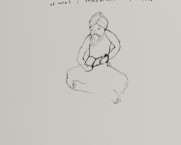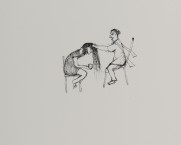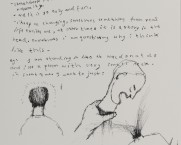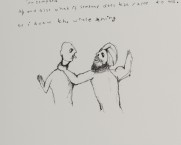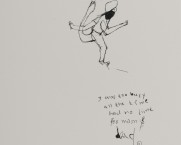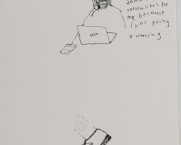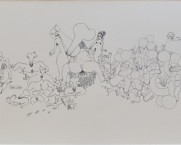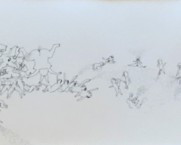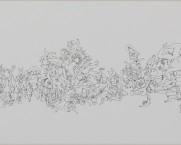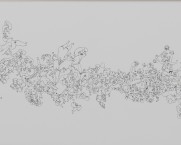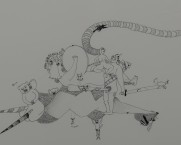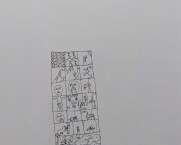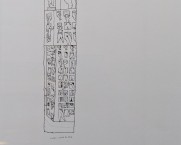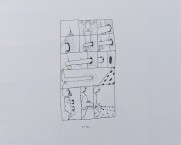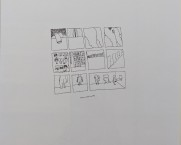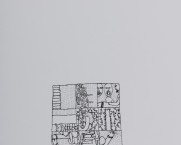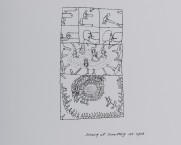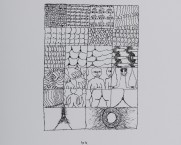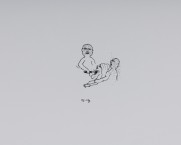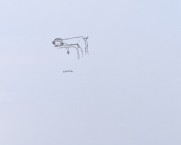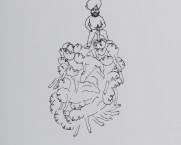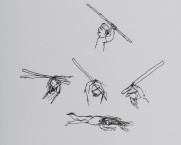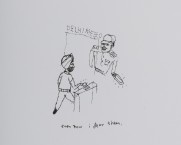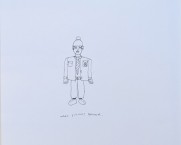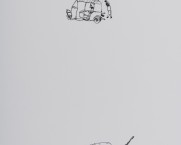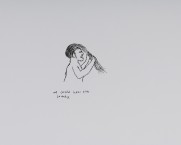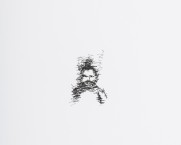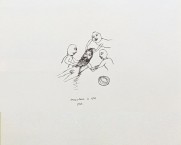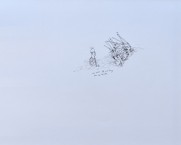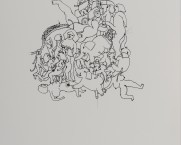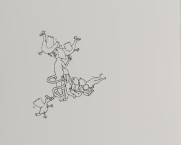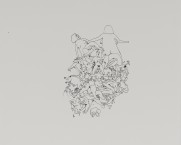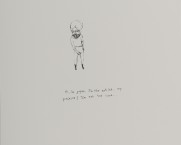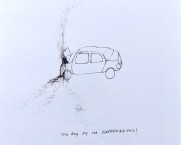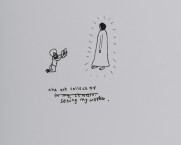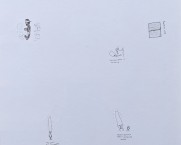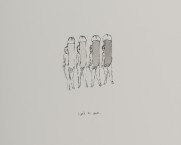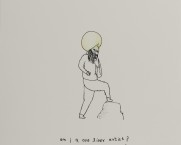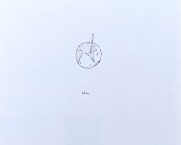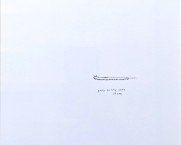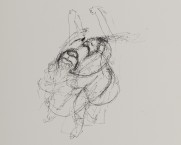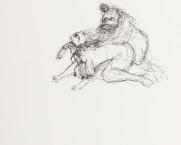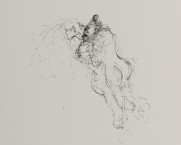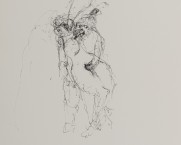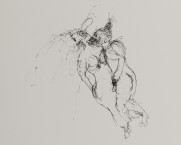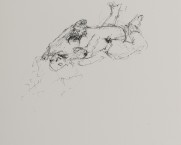C&L Shows
What I Did Every Day
Gagan Singh
19 September - 7 November
2019
2019

Overview
24 Points of Entry
— Zeenat Nagree
- What can drawing do? What can be done in drawing? In case of confusion, refer to Gagan Singh’s video tutorial How to draw things.
- In his drawings, Gagan Singh restages memories and orchestrates transgressive situations. It is not always possible to distinguish one from the other.
- After momentarily accepting this conundrum for what it is, you might still ask yourself: did all of these events actually take place? You could consult the extensive literature on Khajuraho for some answers, say The Religious Imagery of Khajuraho (1996) by Devangana Desai, in which the art historian proposes functions other than that of providing “delight to people”. In 1979, Michael W. Meister suggested that the erotic scenes are architectural puns as they are depictions of carnal unions where walls join each other.
- Gagan Singh enjoys making puns and jokes in general. (Follow the caterpillar going to the shoe store.)
- If we can’t be certain about the biographical in Gagan Singh’s drawings, we can definitely rely on the extraordinary acrobatics of the biological. In one of his books, he makes a manual for the penis: “roll it when not in use” or “fold it if you can” etc. In this sequence, the penis keeps transforming to such an extent that it is unclear what kind of a thing it is, perhaps an apparatus that has broken away from the sexual. What then drives this mechanism?
- This crisis is, at times, expressed as alienation from pleasure. See the panels Work, Factory and Holes.
- Or, not. In The Sex Appeal of the Inorganic (2004), philosopher Mario Perniola writes, “To give oneself as a thing that feels and to take a thing that feels is the new experience that asserts itself on contemporary feeling, a radical and extreme experience…It would seem that things and senses are no longer in conflict with one another but have struck an alliance thanks to which the most detached abstraction and the most unrestrained excitement are almost inseparable and are often indistinguishable.”
- The body becomes both thing and site through drawing. It is to be looked at, not looked away from. See the panels Room with a view and I wish I could do this. While these images address the taboo on expression of sexuality in public spaces through exaggeration, they also suggest that sexual activity is everywhere in the cityscape. Can we locate desire or pleasure in them?
- Sometimes, drawing becomes a mode of doing the impermissible. In a sketchbook entry from the 6th of June 2012, from a series on his father’s final days and death, Gagan Singh writes:
i am standing in line at mcdonald’s and i see a person with very small neck. in front of me. i want to just: break his neck. uproot it like a weed.
so i not do because:
a) i live in civilised world
b) against the LAW
c) and i have no right to take anyone’s life even though i am tempted
d) and also what if someone does the same to meso i draw the whole thing
- Through hyperbolic opposition, Gagan Singh creates an alternative universe to societies that prescribe normative behaviour and advocate carnal control. This universe could be thought of as a ‘reflection’ of contemporary Indian society – a reflection in which there is a complete reversal. The absurdity and humour of the drawings release the pressure of conformity exercised through socialisation at school, within the family, and by the state. Laughter is proposed as a point of exit.
- Taking this further, one of the principal concerns of Gagan Singh’s work is transgression. This transgression may look grotesque as pain and pleasure intersect. See the Scrolls. Georges Bataille thought that “the domain or eroticism is the domain of violence, of violation,” an idea he expanded in Erotism: Death and Sensuality (1962).
- The female body is an ‘other’ subject under the artist’s gaze, and this body is often depicted in states of sexual hyperactivity and orgiastic excess. There are emoticons for heads, and bullseyes for nipples. The flesh sometimes flattens into a cartoon. See the Clusters and the Scrolls.
- In one case, the female body becomes an insurmountable wonderland where fascination and fear strive for supremacy. During the course of this dizzying experience, the diminutive caricature of the artist experiences free fall. You will recognise the drawing when you see it.
- Contact and co-existence between bodies that appear to be within the norm and those that defy normative expectations are found in some of Gagan Singh’s Scrolls.
- Back in 1983, William K. Stevens writing in The New York Times proclaimed that there was “sexual repression in the land of the Kama Sutra” but also stated that “signs of change are beginning to appear” and that “they are so pervasive that in another few years they could produce a transformation in sexual attitudes and practices.”
- Two decades later, sociologist Jyoti Puri argued that the land of the Kama Sutra was not quite so libidinal in its time anyway. Details of Puri’s intersectional critique can be found in an essay titled “Concerning Kamasutras: Challenging Narratives of History and Sexuality.”
- Around the time that Puri published her essay, anthropologist William Mazzarella presented his analysis of the 1991 KamaSutra condom advertising campaign, which he described as a “watershed moment” in Bombay public culture. In Shoveling Smoke: Advertising and Globalization in Contemporary India (2003), Mazzarella stated that this the eroticisation of consumption stood sharply against the ‘anti-erotics’ of the government, which had been promoting nirodh or restraint as the path to family planning.
- Drawing a longer line into the past, we find that the construction of masculinity during the struggle to overthrow colonial power involved the practice of celibacy – both by the emaciated Gandhi and the robust Chandrashekhar Azad.
- Gagan Singh mocks the continued state-sanctioned anti-eroticism in his video tutorial How to draw things and in his book with drawings where the penis is instructed to “talk less,” “study geometry,” and “be humble.” The subject addressed there is the ‘Ideal Boy,’ whose hygiene and other bodily functions have already been regulated through widely distributed pedagogical posters. (The figure of the artist and the workings of the art market are also subject to ridicule. Anxiety rubs against the necessity to submit to the rules of a system.)
- Where can the erotic be expressed? Audre Lorde spoke compellingly about the suppression of the erotic force in women in heteronormative societies in her 1978 speech, “Uses of the Erotic.” Could we extend Lorde’s understanding to the suppression of the erotic among men within the Indian context today to think about the resulting display of power as the central expression of toxic, hegemonic masculinity? That is, India with a penis sticking out of its map, as Gagan Singh draws it.
- Gagan Singh draws out the shame and loss of honour that is integral to the operation of violence during riots in works on the personal experience and collective recollections of the 1984 pogrom against the Sikh community.
- A subset within this series is given over to retribution rather than reconciliation. What is the distance between what is willed in drawing and its enactment in the world?
- A significant length of time separates the drawings of the 1984 riots from those that chronicle the death of Gagan Singh’s father from a heart condition in 2012. Displacement and the difficulties of return fill the period in between. The exploration of the complexity of attachment and loss allow a rupture from the critique of dominant masculinity towards tenderness.
- Writing about drawing his father in his coffin, John Berger says in 1976, “…the visual is always a result of an unrepeatable, momentary encounter. Appearances, at any given moment, are a construction emerging from the debris of everything that has previously appeared.”
Works


